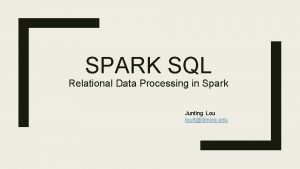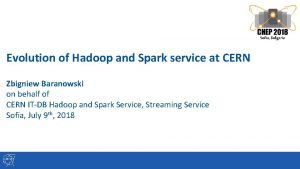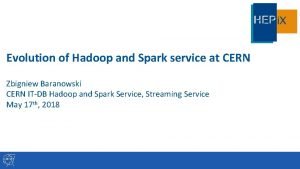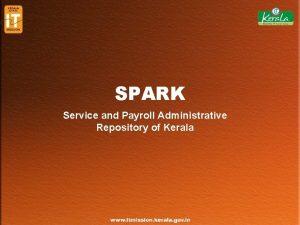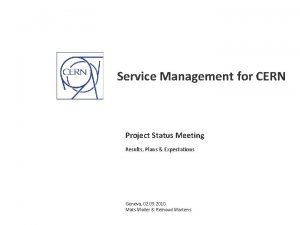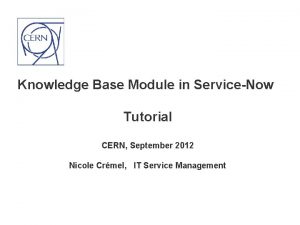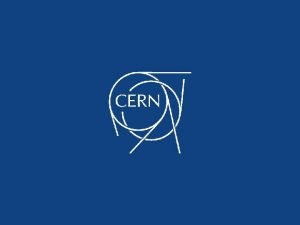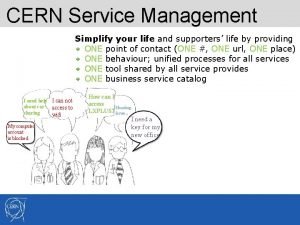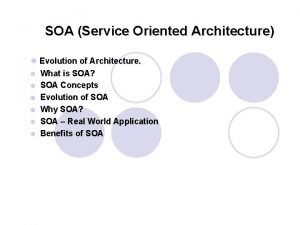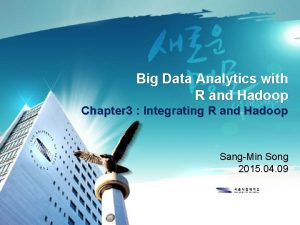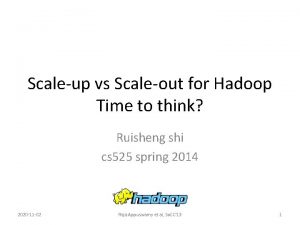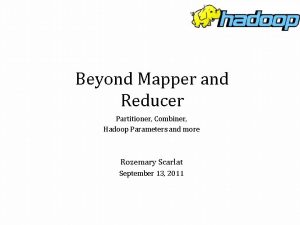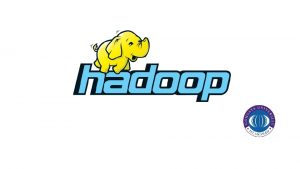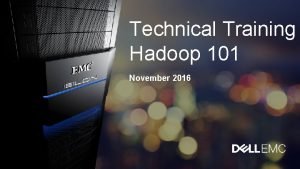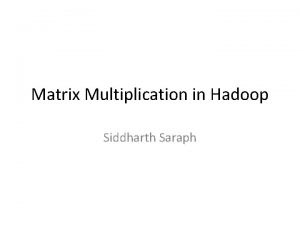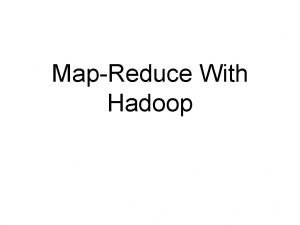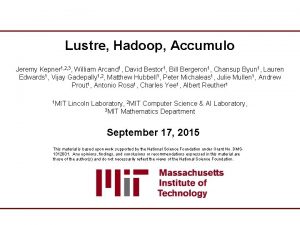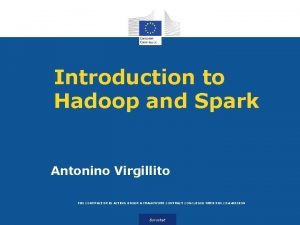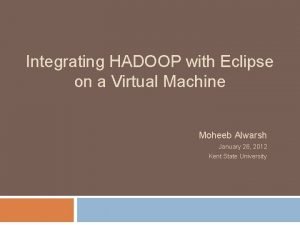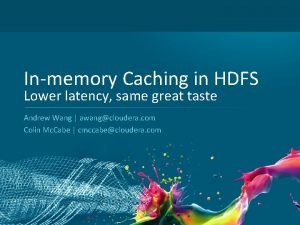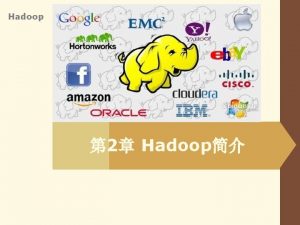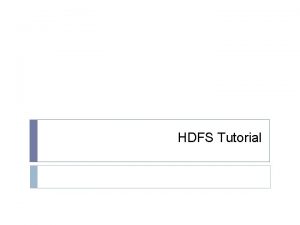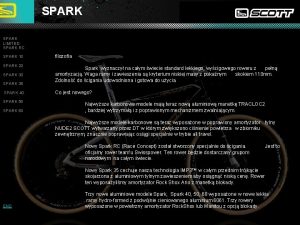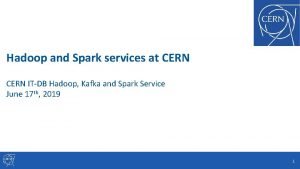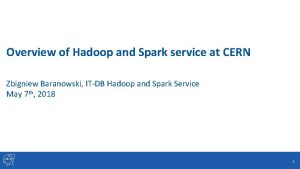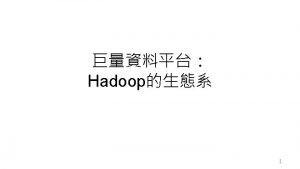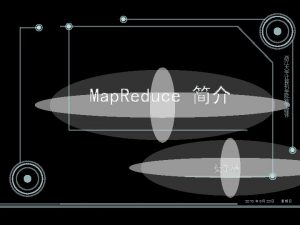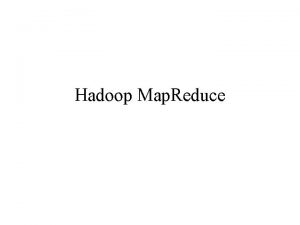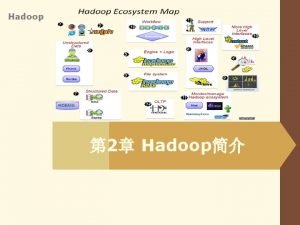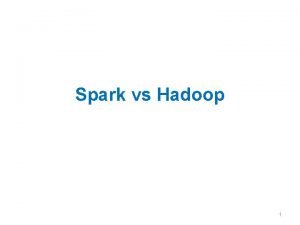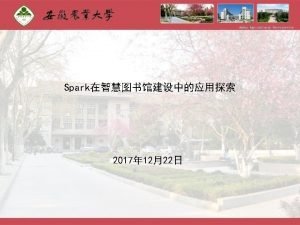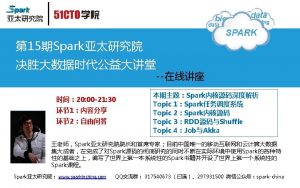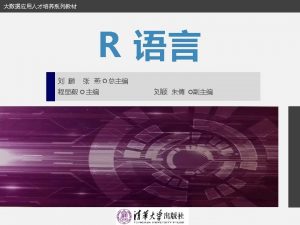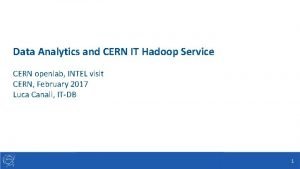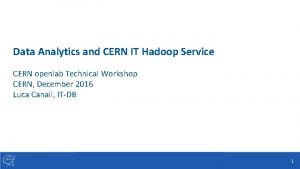Evolution of Hadoop and Spark service at CERN


























- Slides: 26

Evolution of Hadoop and Spark service at CERN Zbigniew Baranowski CERN IT-DB Hadoop and Spark Service, Streaming Service May 17 th, 2018

Hadoop and Spark for big data analytics • Distributed systems for data processing • Storage and multiple data processing interfaces • Can operate at scale by design (shared nothing) • Typically on clusters of commodity-type servers/cloud • Many solutions target data analytics and data warehousing • Can do much more: stream processing, machine learning • Already well established in the industry and open source Scale-out data processing 2

CERN Hadoop Service - Timeline � 2013 Start of Hadoop pilot service � 2014 Adoption of Hadoop 2 (YARN) and Apache Spark � 2015 � Adoption of SQLbased solutions (Hive, Impala) 2016 • Starting Kafka pilot • Rolling out HDFS backups • XRD connector and monitoring � 2017 Production ready High availability, Custom CERN distribution LHC critical projects Start of CMS commits Big Data project to use the service Central IT Started R&D First secured Monitoring with other cluster project RDBMSdeployed moves to based First projects Hadoop projects by ATLAS Second Third cluster and cluster installed CASTOR installed � 2018 Adoption of Jupyter Notebooks (SWAN) Fourth cluster Spark cluster on installed Kubernetes (for LHC mission critical systems) IT Security Start of series of introduction project training moves to Hadoop 3

Hadoop Service at CERN IT • Setup and run the infrastructure • Support user community • Provide consultancy • Ensure knowledge sharing • Train on the technologies 4

Hadoop service in numbers ² 6 clusters 4 production (bare-metal) ² 2 QA clusters (VMs) ² 20+ TB of Memory ² 1500+ physical cores ² HDDs and SDDs ² Data growth: 4 TB per day ² ² 110+ physical servers ² 40+ virtual machines ² 14+ PBs of Storage CPU 5

Overview of available components in 2018 Kafka: streaming and ingestion 6

Hadoop and Spark production deployment ² Software distribution ² ² ² ² ² automatic master failover for HDFS, YARN and HBASE via CERN IT Monitoring infrastructure Service level monitoring (since 2017) ² ² ² no service downtime transparent in most of the cases Host monitoring and alerting ² authentication Kerberos fine-grained authorization integrated with e-groups (since 2018) High availability (since 2017) Rolling change deployment ² Cent. OS 7. 4 custom Puppet module Security ² ² ² Cloudera (since 2013) Vanilla Apache (since 2017) Installation and configuration ² ² ² metrics integrated with: Elastic + Grafana custom scripts for availability and alerting HDFS backups (since 2016) ² ² Daily incremental snapshots Sent to tapes (CASTOR) 7

XRoot. D connector for Hadoop and Spark • A library that binds Hadoop-based file system API with XRoot. D native client • Developed by CERN IT • Allows most of components from Hadoop stack (Spark, Map. Reduce, Hive etc) to read from/write to EOS and CASTOR directly • Works with Grid certificates and Kerberos for authentication • Used for: HDFS backups, performing analytics on data stored on EOS (CERNBox) C++ Java EOS Storage System Xroot. D Xrootd Client JNI Hadoop. Xroot. D Connector Hadoop HDFS Spark (analytix) 8

Moving to Apache Hadoop distribution (since 2017) • Better control of the core software stack • • • We do rpm packaging for core components • • Independent from a vendor/distributor In-house compilation Enabling non-default features (compression algorithms, R for Spark) Adding critical patches (that are not ported in upstream) HDFS and YARN, Spark, HBase Streamlined development • Available on Maven Central Repository 9

Apache Kafka - data streaming at scale • • Apache Kafka streaming platform becomes a standard component for modern scalable architectures Started providing Kafka as a pilot service in 2017 10

SWAN – Jupyter Notebooks On Demand • Service for web based analysis (SWAN) • • An interactive platform that combines code, equations, text and visualizations • • Developed at CERN, initially for physics analysis by EP-SFT and IT-ST Ideal for exploration, reproducibility, collaboration Fully integrated with Spark and Hadoop at CERN (2018) • • • Python on Spark (Py. Spark) at scale Modern, powerful and scalable platform for data analysis Web-based: no need to install any software 11

Text Code Monitoring Visualizations 12

SWAN_Spark – Architecture SSO Web portal Spark Worker Python task Container Scheduler User 1 User 2 Python task User n Spark Driver App. Master EOS (Data) CERN Resources CVMFS (Software) CERNBox (User Files) IT Hadoop and Spark clusters 13

Spark as a service on a private cloud • • Under R&D since 2018 Appears to be a good solution when data locality is not needed • • Spark clusters - on containers • • • CPU and memory intensive rather than IO intensive workloads Reading from external storages (AFS, EOS, foreign HDFS) Compute resources can be flexibly scale out Kubernetes over Openstack Leveraging the Kubernetes support in Spark 2. 3 Use cases • • Ad-hoc users with high demand computing resource demanding workloads Streaming jobs (e. g. accessing Apache Kafka) 14

Analytics platform outlook • High throughput IO and compute workloads • Established systems • Flexible scalability for compute intensive workloads • Ad-hoc users 15

Selected “Big Data” Projects at CERN

Next Gen. CERN Accelerator Logging • • • A control system with: Streaming, Online System, API for Data Extraction Critical system for running LHC - 700 TB today, growing 200 TB/year Challenge: service level for critical production Credit: Jakub Wozniak, BE-CO-DS 17

New CERN IT Monitoring infrastructure Critical for CC operations and WLCG Data Sources AMQ FTS Storage & Search Transport Flume AMQ DB Flume DB HTTP feed Flume HTTP Logs Flume Log GW Kafka cluster (buffering) * Data Access HDFS Rucio XRoot. D Jobs Flume Kafka sink … Lemon syslog app log Lemon metrics Flume Metric GW Flume sinks Processing Elastic Search Data enrichment Data aggregation Batch Processing … CLI, API Others (influxdb) • Data now 200 GB/day, 200 M events/day • At scale 500 GB/day • Proved to be effective in several occasions Credits: Alberto Aimar, IT-CM-MM 18

The ATLAS Event. Index Catalogue of all collisions in the ATLAS detector • • Over 120 billion of records, 150 TB of data Current ingestion rates 5 k. Hz, 60 TB/year WLCG Events metadata extraction Data file Meta. File CERN Data enrichment Grid job • Object Store Analytics Web UI Mapfiles + HBase Hadoop Event extraction Web UI Table RDBMS 19

CMS Data Reduction Facility • • R&D, CMS Bigdata project, CERN openlab, Intel: • Reduce time to physics for PB-sized datasets • Exploring a possible new way to do HEP analysis Improve computing resource utilization • Enable physicists to use tools and methods from “Big Data” and open source communities CMS Data Reduction Facility: • Goal: produce reduced data n-tuples for analysis in a more agile way than current methods • Currently testing: scale up with larger data sets, first prototype successful but only used 1 TB 20

R&D: Data Analysis with Py. Spark for HEP EOS Storage Service • Data access – XRoot. D • Reading root files – spark-root • User interface - SWAN 21

Data Ingestion: spark-root 0. 1. 16 available on Maven Central! Scala • spark-root - ROOT I/O for JVM // inject the Dataset[Row] import org. dianahep. sparkroot. experimental. _ val df = spark. read. option(“tree”, <tree. Name>). root(“<path/to/file>”) • Extends Apache Spark’s Data Source API // pretty print of the schema df. print. Schema |-- Particle: array (nullable = true) • Maps each ROOT TTree to Dataset[Row] • Parallelization = # ROOT files. Credits: V. Khristenko, J. Pivarski, diana-hep and CMS Big Data project | |-- element: struct (contains. Null = true) | | |-- f. Unique. ID: integer (nullable = true) | | |-- f. Bits: integer (nullable = true) | | |-- PID: integer (nullable = true) | | |-- Status: integer (nullable = true) | | |-- Is. PU: integer (nullable = true) | | |-- M 1: integer (nullable = true) | | |-- M 2: integer (nullable = true) | | |-- D 1: integer (nullable = true) | | |-- D 2: integer (nullable = true) | | |-- Charge: integer (nullable = true) | | |-- Mass: float (nullable = true) | | |-- E: float (nullable = true) 2 2 22

Data Processing: CMS Open Data Example Let’s calculate the invariant mass of a di-muon system? ! • Transform a collection of muons to an invariant mass for each Row (Event). • Aggregate (histogram) over the entire dataset. # read in the data df = sql. Context. read. format(“org. dianahep. sparkroot. experimental”). load(“hdfs: /path/to/files/*. root”) # count the number of rows: df. count() # select only muons = df. select(“pat. Muons_slimmed. Muons__RECO_. pat. Muons_slimmed. Muo ns__RECO_obj. m_state”). to. DF(“muons”) # map each event to an invariant mass inv_masses = muons. rdd. map(to. Inv. Mass) # Use histogrammar to perform aggregations empty = histogrammar. Bin(200, 0, 200, lambda row: row. mass) h_inv_masses = inv_masses. aggregate(empty, histogrammar. increment, histogrammar. combine) Credits: V. Khristenko, J. Pivarski, diana-hep and CMS Big Data project 23

Conclusions • Demand of “Big Data” platforms and tools is growing at CERN • • Many projects started and running Projects around Monitoring, Security, Accelerators logging/controls, physics data, streaming… • Hadoop, Spark, Kafka services at CERN IT • Service is evolving: High availability, security, backups, external data sources, notebooks, cloud… • Experience and community • • Technologies evolve rapidly and knowledge sharing very important We are happy to share/exchange our experience, tools, software with others HEP sites welcome to join discussions at Hadoop User Forum: https: //indico. cern. ch/category/5894/ Interest of HEP sites in collaborating with CERN on some projects? 24

Future work • Spark on Kubernetes (continuation) • Rolling out Kafka service in full production state • Improve monitoring of individual users in Hadoop • Service web portal for users Integrate multiple components of the service Single place for monitoring and requesting the service resources • • HDFS quota, CPUs, memory, Kafka topics etc Explore further the big data technology landscape • Presto, Apache Kudu, Apache Beam etc. 25

Acknowledgements Colleagues in the Hadoop, Spark and Streaming Service at CERN • Users of the service, including IT Monitoring, IT Security, ATLAS DDM and Event. Index, CMSSpark project, Accelerator logging and controls • CMS Big Data project, with Intel and openlab • Collaboration on SWAN with CERN colleagues in EP-SFT, IT-ST • 26
 Data integrity in hadoop
Data integrity in hadoop Spark sql: relational data processing in spark
Spark sql: relational data processing in spark Evolution of hadoop
Evolution of hadoop Evolution of hadoop
Evolution of hadoop Sparkpayroll
Sparkpayroll Silva service now
Silva service now Service now cern
Service now cern Service now cern
Service now cern Cern add printer
Cern add printer Cern service portal
Cern service portal Soa
Soa What is the sequence of installations on rhipe
What is the sequence of installations on rhipe Scale up and scale out in hadoop
Scale up and scale out in hadoop Mapreduce combiner example
Mapreduce combiner example Pyspark twitter sentiment analysis
Pyspark twitter sentiment analysis Adequate service expectations examples
Adequate service expectations examples Soa architecture
Soa architecture Apache hadoop open source
Apache hadoop open source Hadoop webinar
Hadoop webinar Isilon nitro
Isilon nitro Hadoop matrix multiplication
Hadoop matrix multiplication Hadoop assignment help
Hadoop assignment help Supercloud hadoop
Supercloud hadoop Fsck command in hadoop
Fsck command in hadoop Intro to hadoop
Intro to hadoop Hadoop virtual machine download
Hadoop virtual machine download Hdfs caching
Hdfs caching

